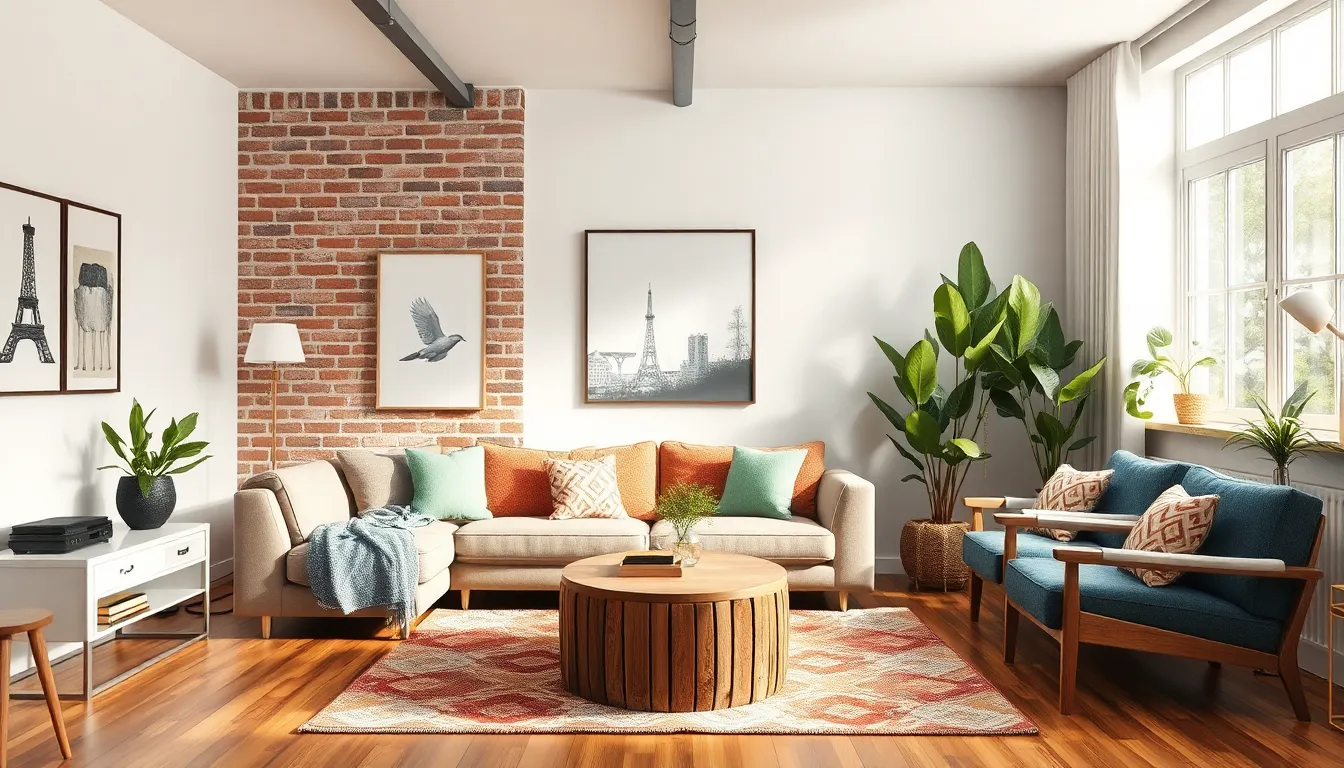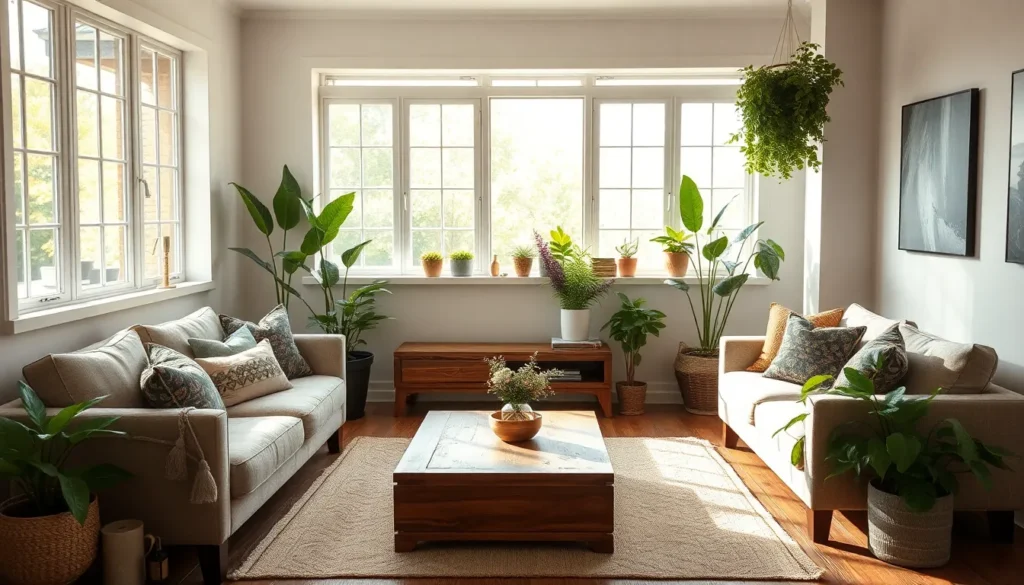Table of Contents
ToggleIn a world bursting with creativity, design styles are the secret sauce that transforms ordinary spaces into extraordinary experiences. Whether it’s the sleek lines of modern minimalism or the cozy charm of rustic farmhouse, each style has its own personality and flair. Choosing the right one can feel like dating—sometimes you click, and other times you just can’t see a future together.
But fear not! Navigating through the sea of design styles doesn’t have to be a daunting task. With a little guidance, anyone can find the perfect match for their space. So grab a cup of coffee, put on your favorite playlist, and let’s dive into the colorful world of design styles that’ll make your home not just a place to live, but a true reflection of who you are.
Overview of Design Styles
Design styles define the aesthetics of spaces, offering distinct atmospheres that influence how individuals feel and interact within their environments. Each style carries unique characteristics, contributing to its overall identity. Modern minimalism emphasizes clean lines and functional elements, creating uncluttered environments that promote relaxation. In contrast, rustic farmhouse design embraces natural materials, evoking warmth and a sense of comfort.
Traditional styles reflect historical influences, often featuring ornate details and rich fabrics. Eclectic designs blend various styles and time periods, allowing for personal expression through a curated mix of furnishings and decor. Each of these styles serves a particular purpose, catering to different preferences and lifestyles.
Understanding these styles facilitates informed decision-making. Contemporary designs showcase current trends, often incorporating innovative materials and technologies. Industrial design highlights raw, unfinished elements, commonly seen in urban settings. Coastal styles exude a light and breezy vibe with colors inspired by the sea and beach.
Transitional design strikes a balance between traditional and modern aesthetics, achieving a harmonious blend that appeals to a wide range of tastes. By exploring various design styles, individuals can discover what resonates most with their personal taste.
Ultimately, identifying the right design style can transform a living space, creating an atmosphere that aligns with individual preferences and enhances overall well-being. Each style presents opportunities for personalization, ensuring that spaces reflect the unique identities of their inhabitants.
Popular Design Styles

Exploring popular design styles reveals distinct aesthetics that cater to various preferences. Each style brings its unique charm to spaces, allowing individuals to express their identity.
Minimalism
Minimalism emphasizes simplicity and functionality. Clean lines, uncluttered surfaces, and a limited color palette create a serene environment. This style often incorporates essential furniture pieces to enhance openness and avoid distractions. Light fills the space, and materials like wood and metal are common. The focus on fewer items promotes relaxation and peace, making it ideal for people seeking a tranquil atmosphere at home.
Industrial
Industrial design draws inspiration from warehouses and factories. Raw materials like exposed brick, concrete, and steel contribute to a rugged yet stylish vibe. Open layouts often feature high ceilings and large windows for abundant natural light. This style celebrates imperfections, showcasing elements like ductwork and pipes. Furniture tends to be robust, with a mix of vintage and modern pieces, providing an eclectic feel that appeals to urban dwellers.
Scandinavian
Scandinavian design embodies simplicity and functionality, focusing on minimalism with warmth. Light woods and soft textiles create an inviting atmosphere. This style prioritizes natural lighting, often incorporating large windows to brighten interiors. Neutral colors dominate, accented by bold hues through decor and artwork. Emphasis on craftsmanship results in durable furniture, ensuring both aesthetic appeal and practicality.
Bohemian
Bohemian design reflects a carefree and artistic spirit. Layers of colors, patterns, and textures generate vibrant spaces full of personality. Furniture pieces come from various cultures and eras, resulting in a curated, global aesthetic. Incorporating plants and handmade decor adds life and warmth. This style encourages creativity, allowing individuals to express their unique stories through each carefully chosen element.
Mid-Century Modern
Mid-century modern design features clean lines and organic forms that prioritize functionality. Characterized by a seamless blend of indoor and outdoor spaces, large windows allow nature to integrate with interiors. Bright colors and geometric shapes define this style, making bold statements in furniture design. Iconic pieces from designers like Eames and Saarinen showcase timeless elegance while remaining highly sought after. Function meets style, appealing to those who value both aesthetics and usability.
Elements of Design Styles
Elements of design styles shape the overall character of a space. They include color palettes, furniture selections, textures and materials, as well as lighting choices.
Color Palette
Color palettes define the mood and energy of a room. Soft neutrals create calm spaces, promoting relaxation. Bold hues energize a space, inspiring creativity. Choosing complementary colors enhances harmony. Designers often use a color wheel to ensure balance. A well-thought-out palette strengthens a space’s identity. Trends like monochromatic schemes simplify decisions, allowing for high impact with fewer tones.
Furniture Selection
Furniture selection drives functionality and aesthetics. Each piece should reflect the chosen design style. Modern styles favor sleek, minimalist pieces, while traditional designs call for ornate selections. Comfort influences choices, so seating must accommodate daily use while enhancing the visual appeal. Mixing and matching pieces can create an eclectic look, reflecting personal taste. Designers also consider scale, ensuring furniture fits proportionately within the space.
Texture and Material
Texture and material add depth and interest to interiors. Soft fabrics provide comfort, while metal finishes create modern contrasts. Mixing various textures heightens visual appeal and dimensionality. Natural materials like wood and stone evoke warmth and sustainability. Choosing eco-friendly options also demonstrates a commitment to the environment. Designers often layer textures for a cozy atmosphere, blending smooth surfaces with tactile fabrics.
Lighting Choices
Lighting choices significantly impact a room’s ambiance. Different types of lighting fulfill various functional needs. Ambient lighting offers general illumination, while task lighting focuses on specific areas. Accent lighting highlights art or architectural details, creating visual interest. Designers consider the color temperature of light, as warmer tones encourage relaxation. Incorporating multiple light sources enhances versatility, allowing customization of the overall mood.
Trends in Design Styles
Current trends in design styles reflect a blend of functionality, sustainability, and personal expression. These elements continuously evolve, shaping the environments people inhabit.
Sustainable Design
Sustainable design emphasizes eco-friendly practices and materials. Using reclaimed wood, recycled materials, and energy-efficient appliances reduces a space’s carbon footprint. Designers prioritize natural lighting and ventilation to enhance energy efficiency. Organic textiles and low-VOC paints promote healthier living environments. By incorporating plants, they also improve indoor air quality, fostering a connection with nature. Eco-conscious design appeals to those seeking beauty that aligns with environmental responsibility.
Smart Home Integration
Smart home integration elevates the convenience and efficiency of living spaces. Automated lighting, heating, and security systems adapt to individual lifestyles. Technology enhances comfort, allowing occupants to control home environments from their smartphones. Voice-activated devices add an element of ease in daily tasks. This trend aligns with modern minimalism, where functionality blends seamlessly with aesthetics. As more homeowners embrace tech-driven solutions, design styles incorporate these innovations to create smarter, more connected spaces.
Eclectic Combinations
Eclectic combinations showcase personal style through diverse elements. Mixing vintage and contemporary pieces adds character to living areas, creating layered visual interest. Designers often experiment with various color palettes, textures, and furniture styles to harmonize different influences. This approach encourages creativity, reflecting the unique identities of individuals. Bold patterns and unexpected juxtapositions break conventional design norms. As eclecticism grows in popularity, it fosters environments that feel vibrant and expressive.
Embracing a design style can truly elevate a living space and reflect personal identity. With various options available individuals can explore styles that resonate with their tastes and lifestyles. Whether opting for the sleek lines of modern minimalism or the cozy charm of rustic farmhouse design each choice offers a unique way to enhance ambiance and functionality.
By considering essential elements like color palettes textures and lighting individuals can create harmonious environments that not only look beautiful but also feel inviting. Staying informed about current trends allows for a blend of sustainability and innovation ensuring spaces remain relevant and enjoyable. Ultimately the right design style can transform any home into a sanctuary tailored to individual preferences.




